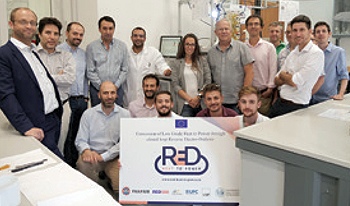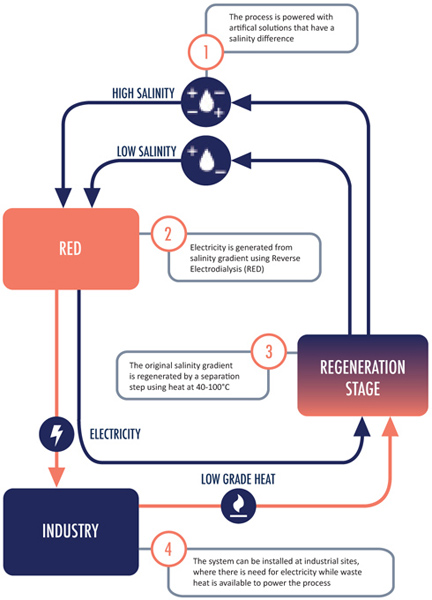 A new world record to help the planet
A new world record to help the planet
The sustainability challenges facing Europe and the whole world are often defined by what society lacks rather than what we waste.
Rightly, policy makers and campaigners focus on what could well be in short supply or even extinction by 2020 or 2050, but there is also much to be gained from exploring what we have but waste right now.
Every day, large amounts of primary energy are wasted in the form of low temperature heat. This overlooked but valuable resource is simply discarded into the environment – indirectly, or via cooling facilities at industrial plants across the European continent.
Turning this lost heat – this lost opportunity - into a new, clean source of energy was the driving force behind the RED Heat-to-Power project.
Established in 2015 and funded by the European Commission, the RED Heat-to-Power project brings together a partnership of corporates, academics and small, innovative businesses from across Europe; including FUJIFILM which is bringing its membrane technology to the energy sector, REDstack from the Netherlands, the universities of Palermo (UNIPA), Edinburgh (UEDIN) and Catalunya (UPC) and the Spanish research centre CIEMAT-PSA. The project is managed by WIP, a trail-blazing consultancy based in Munich which has been working on renewable energy projects for the last 35 years.
Together, the consortium has developed a game-changing approach to turn this waste of primary energy to electricity, achieving world record results.
As the graphic below shows, in the RED Heat-to-Power project electricity is generated from salinity gradients using Reverse Electrodialysis (RED) in a closed-loop system, with artificial saline solutions being used as working fluids.
The solutions which exit the RED unit are then regenerated using the low-temperature heat to restore the original salinity gradient, and inspiring the system's name; the RED Heat Engine.
Michael Papapetrou, the project coordinator from WIP said: "The RED Heat-to-Power project has developed the materials, components and know-how required to turn low grade heat into power, to the point where we now have several prototypes operating in the lab. We have successfully gone through the proof of concept phase
and are now moving towards optimisation and scale-up, which means the RED Heat Engine has great potential to contribute to the mix that will form the backbone of the future energy system."
 From the last three years, four things stand out about this exciting new project;
From the last three years, four things stand out about this exciting new project;
1) Competitive electricity generation:
The use of artificial solutions provides the flexibility to choose the salts and the conditions that maximise the productivity of the Reverse Electrodialysis process, making it possible to drive costs down.
2) Exploiting widely available low-grade heat:
The system can be installed practically anywhere in the world as low-grade heat can come from renewable sources like solar or geothermal while most industrial sites also have waste heat availability.
3) Offering flexibility to the power system:
The technology is a fully controllable source of electricity. This flexibility is a distinctive advantage over variable renewable energy, but also against conventional thermal technologies, which are not very flexible
4) A safe and clean source of energy:
The technology involves only simple circulation pumps and any noise will be minimal. There are very low operation and maintenance requirements.
Reflecting on the project's progress since 2015, the partners have much to be upbeat about – especially two world record performance milestones;
- Record power density in the RED system of 39 W per m2 of cell pair
- Record minimum specific thermal energy consumption of Membrane Distillation: 46.1 kWhth/m3
In a new video about RED Heat-to-Power’s achievements so far (https://youtu.be/HgZCcWijSp0) Andrea Cipollina of the University of Palermo said: "We started working three years ago from scratch. We started building new knowledge based on experimental and modelling activities and based on this we developed a process that enabled us to build the first operating pilot system."
Sebastian Mortier, from the European Commission, said: "We are glad to have projects like RED Heat-to-Power to show that we are confronting real issues in a sound manner and that innovation can happen wherever in Europe. Good collaboration, and cross-border collaboration, are very important to us. This project is a good showcase for that."
The next step is taking the RED Heat Engine to scale. From detailed modelling and simulation, results show the most efficient regeneration technology is multiple effect distillation (MED). When MED is used, efficiencies of conversion close to 10% can be achieved for waste heat at 100°C, while levelised cost of electricity (LCOE) below 0.10 Euro/kWh is possible, reaching values below 0.05 Euro/kWh over the next two decades.
Analysis shows there are large amounts of heat available to power the heat engine across Europe and beyond. These resources are mostly in the form of industrial waste heat. The most applicable sources of heat are:
- Industrial sector. It includes various segments with different characteristics of waste heat (temperature, heat capacity, and thermal carrier).
- Decentralized power plants based on biogas engines. Biogas plants reject large amounts of waste heat, with a fraction already utilized for CHP operation or even for the biogas production. The remaining can be recovered by the proposed technology for electricity production.
- Marine sector. Ships are using low/medium speed internal combustion engines for their propulsion, which are already equipped with heat recovery systems for steam production in most cases. However, in the auxiliary engines on-board only their exhaust gases are exploited, with large amounts of waste heat in their cooling circuit (cooled by seawater) readily available.
- Gas compression stations. For the supply of natural gas in the long piping networks, gas compression stations are used, which usually operate with gas turbines fuelled with natural gas. These reject large amounts of waste heat in their exhaust gases.
Michael Papapetrou said: "We have analysed the potential environmental impacts which shows the substitution of grid electricity with electricity generated by the RED Heat Engine would lead to reduced environmental impacts. All the partners are inspired and excited by the potential of the RED Heat-to-Power project."

For further information contact:
Michael Papapetrou
Tel: +49 89 72012712
Email: michael.papapetrou@wip-munich.de
This project has received funding from the European Union's Horizon 2020 research and innovation programme under grant agreement No 640667. The sole responsibility for the content of this article lies with the authors. It does not necessarily reflect the opinion of the European Union. Neither the INEA nor the European Commission are responsible for any use that may be made of the information contained therein.